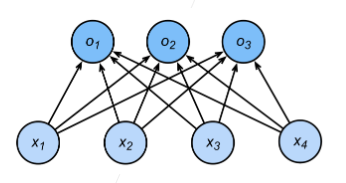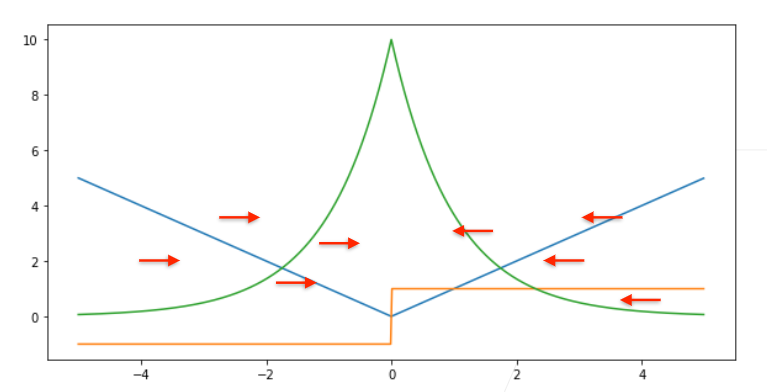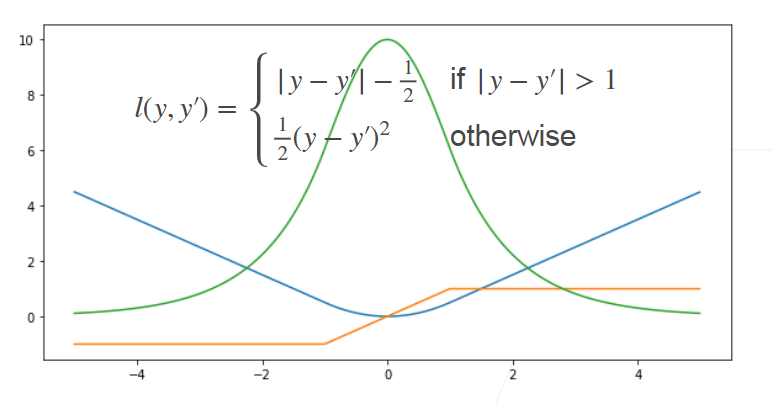09-Softmax 回归
09-softmax 回归
本节目录:
1.回归 VS 分类:
- 回归估计一个连续值
- 分类预测一个离散类别

1.1 从回归到多类分类:
回归:
- 单连续数值输出
- 自然区间 R
- 跟真实值的区别作为损失

分类:
-
通常多个输出
-
输出 i 是预测为第 i 类的置信度

均方损失:
-
对类别进行一位有效编码
 
-
使用均方损失训练
-
最大值为预测 
无校验比例
-
对类别进行一位有效编码
-
最大值为预测 
-
需要更置信的识别正确类(大余量)  )
校验比例
-
输出匹配概率(非负,和为 1)  )
}{\sum{k} exp(o_k)} )
-
概率 y 和$\hat{y}$的区别作为损失
1.2 Softmax 和交叉熵损失
-
交叉熵用来衡量两个概率的区别$H(p,q)=\sum_{i} -p_{i}log(q_i)$
-
将它作为损失 =-\sum*{i}y*{i}log\hat{y_{i}}=-log\hat{y_y} )
-
其梯度是真实概率和预测概率的区别 =softmax(o){i}-y{i} )
Softmax 回归是一个多类分类模型
使用 Softmax 操作子得到每个类的预测置信度
使用交叉熵来衡量和预测标号的区别
2.损失函数

2.1 L2 Loss
=\frac{1}{2}(y-y^{’})^2 )

梯度会随着结果逼近而下降
2.2 L1 Loss
=\lvert y-y^{’}\rvert )

梯度保持不变,但在 0 处梯度随机
2.3Huber’s Robust Loss

结合 L1 Loss 和 L2 Loss 的优点
3.图片分类数据集
3.1 Fashion-MNIST 数据集:
-
读取数据集
trans=transforms.ToTensor() mnist_train=torchvision.datasets.FashionMNIST(root="../data",train=True, transform=trans,download=True) mnist_test=torchvision.datasets.FashionMNIST(root="../data",train=False, transform=trans,download=True) -
数据集内图片大小
mnist_train[0][0].shape torch.Size([1, 28, 28])表示图片为单通道(黑白)的 28X28 的图片
-
显示数据集图像
X,y = next(iter(data.DataLoader(mnist_train,batch_size=18))) show_images(X.reshape(18,28,28),2,9,titles=get_fashion_mnist_labels(y))
4.从零实现 softmax 回归
softmax:
$$ softmax(X){ij}=\frac{exp(X{ij})}{\sum_{k} exp(X_{ik})} $$
def softmax(X):
X_exp = torch.exp(X)
partition = X_exp.sum(1, keepdim=True)
return X_exp / partition
-
将图像展平,每个图像看做长度为 784 的向量,因为数据集有十个类别,所以网络输出维度为 10。以此设定参数大小并初始化:
num_inputs = 784 num_outputs = 10 W = torch.normal(0, 0.01, size=(num_inputs, num_outputs), requires_grad=True) b = torch.zeros(num_outputs, requires_grad=True) -
实现 softmax 回归模型:
def net(X): return softmax(torch.matmul(X.reshape((-1, W.shape[0])), W) + b) -
实现交叉熵损失函数:
def cross_entropy(y_hat, y): return - torch.log(y_hat[range(len(y_hat)), y]) -
计算正确率:
def accuracy(y_hat, y): """计算预测正确的数量""" if len(y_hat.shape) > 1 and y_hat.shape[1] > 1: y_hat = y_hat.argmax(axis=1) cmp = y_hat.type(y.dtype) == y return float(cmp.type(y.dtype).sum()) -
评估 net 精度
def evaluate_accuracy(net, data_iter): """计算在指定数据集上模型的精度""" if isinstance(net, torch.nn.Module): net.eval() metric = Accumulator(2) with torch.no_grad(): for X, y in data_iter: metric.add(accuracy(net(X), y), y.numel()) return metric[0] / metric[1]class Accumulator: """在n个变量上累加""" def __init__(self, n): self.data = [0.0] * n def add(self, *args): self.data = [a + float(b) for a, b in zip(self.data, args)] def reset(self): self.data = [0.0] * len(self.data) def __getitem__(self, idx): return self.data[idx] -
定义训练模型:
def train_ch3(net, train_iter, test_iter, loss, num_epochs, updater): """训练模型(定义见第3章)""" animator = Animator(xlabel='epoch', xlim=[1, num_epochs], ylim=[0.3, 0.9], legend=['train loss', 'train acc', 'test acc']) for epoch in range(num_epochs): train_metrics = train_epoch_ch3(net, train_iter, loss, updater) test_acc = evaluate_accuracy(net, test_iter) animator.add(epoch + 1, train_metrics + (test_acc,)) train_loss, train_acc = train_metrics assert train_loss < 0.5, train_loss assert train_acc <= 1 and train_acc > 0.7, train_acc assert test_acc <= 1 and test_acc > 0.7, test_acc -
预测:
def predict_ch3(net, test_iter, n=6): """预测标签(定义见第3章)""" for X, y in test_iter: break trues = d2l.get_fashion_mnist_labels(y) preds = d2l.get_fashion_mnist_labels(net(X).argmax(axis=1)) titles = [true +'\n' + pred for true, pred in zip(trues, preds)] d2l.show_images( X[0:n].reshape((n, 28, 28)), 1, n, titles=titles[0:n]) predict_ch3(net, test_iter)
5.softmax 的简洁实现
调用 torch 内的网络层
import torch
from torch import nn
from d2l import torch as d2l
batch_size=256
train_iter,test_iter=d2l.load_data_fashion_mnist(batch_size)
net=nn.Sequential(nn.Flatten(),nn.Linear(784,10))
def init_weights(m):
if type(m) == nn.Linear:
nn.init.normal_(m.weight,std=0.01)
net.apply(init_weights)
loss=nn.CrossEntropyLoss()
trainer=torch.optim.SGD(net.parameters(),lr=0.1)
num_epochs=10
d2l.train_ch3(net,train_iter,test_iter,loss,num_epochs,trainer)
6.softmax 回归 Q&A
Q1:softlabel 训练策略以及为什么有效?
softmax 用指数很难逼近 1,softlabel 将正例和负例分别标记为 0.9 和 0.1 使结果逼近变得可能,这是一个常用的小技巧。
Q2:softmax 回归和 logistic 回归?
logistic 回归为二分类问题,是 softmax 回归的特例
Q3:为什么使用交叉熵,而不用相对熵,互信息熵等其他基于信息量的度量?
实际上使用哪一种熵的效果区别不大,所以哪种简单就用哪种
Q4:

为什么我们只关心正确类,而不关心不正确的类呢?
并不是不关心,而是不正确的的类标号为零,所以算式中不体现,如果使用 softlabel 策略,就会体现出不正确的类。
Q5:似然函数曲线是怎么得出来的?有什么参考意义?
最小化损失函数也意味着最大化似然函数,似然函数表示统计概率和模型的拟合程度。
Q6:在多次迭代之后欧如果测试精度出现上升后再下降是过拟合了吗?可以提前终止吗?
很有可能是过拟合,可以继续训练来观察是否持续下降
Q7:cnn 网络主要学习到的是纹理还是轮廓还是所有内容的综合?
目前认为主要学习到的是纹理信息
Q8:softmax 可解释吗?
单纯 softmax 是可解释的,可以在统计书籍中找到相关的解释。
